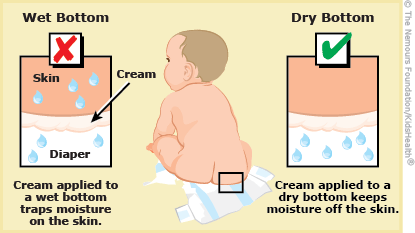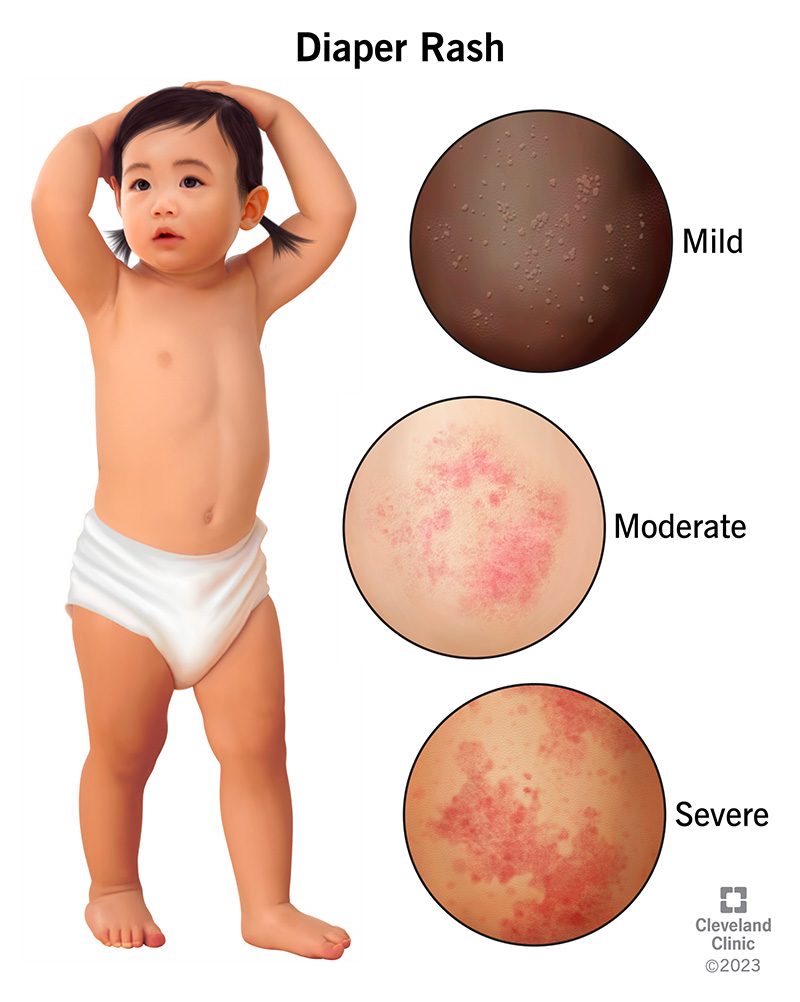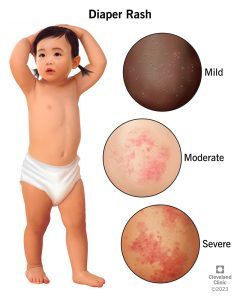Treatment for severe diaper rash, treatment typically involves keeping the affected area clean and dry, using over-the-counter or prescribed ointments, and ensuring the diaper is not causing further irritation. Severe diaper rash can be distressing for both babies and parents, causing discomfort and frustration.
Fortunately, with proper care and attention, it can be effectively treated. It’s essential to maintain good hygiene by changing diapers frequently and cleaning the area gently with mild soap and water. Applying a thick layer of zinc oxide or petroleum jelly can create a barrier between the skin and moisture, helping to promote healing.
In more severe cases, a doctor may prescribe a medicated cream or ointment. Additionally, allowing the baby to have some diaper-free time can also aid in the healing process. Overall, with prompt and consistent treatment, severe diaper rash can be alleviated effectively.

Understanding Diaper Rash
Severe diaper rash can be distressing for both babies and parents. Understanding the causes and seeking appropriate treatment is essential for relieving discomfort and promoting healing.
Understanding Diaper Rash Diaper rash is a common concern for parents and caregivers of infants. It is a red, irritated area on a baby’s skin, often occurring in the diaper area. Understanding the causes and symptoms of diaper rash is crucial for effective treatment and prevention.
Causes Of Diaper Rash, severe diaper rash
Several factors can contribute to diaper rash. These can include prolonged exposure to urine or feces, chafing or rubbing, sensitive skin, yeast or bacterial infections, and introduction to new foods or harsh chemicals in diapers or wipes. It’s important to identify the specific cause in order to determine the most effective treatment plan for the baby’s individual needs.
Symptoms Of Diaper Rash
Diaper rash symptoms may include redness, inflammation, and the development of small bumps or blisters in the diaper area. In severe cases, the skin may become raw, and the baby may experience discomfort or pain. Recognizing these signs early can help in promptly addressing the issue and providing relief for the infant. When dealing with diaper rash, it’s essential to practice good diaper-changing hygiene, use gentle cleansing products, and allow the baby’s skin to air out regularly. Additionally, applying a barrier cream or ointment can provide a protective layer to minimize friction and irritation. Understanding the causes and symptoms of diaper rash is the first step in effectively managing and preventing this common infant ailment.

Identifying Severe Diaper Rash
Identifying severe diaper rash is crucial for proper treatment and relief for your little one. Severe diaper rash is characterized by inflammation, redness, and sores in the diaper area that do not improve with regular diaper rash remedies.
Differences Between Mild And Severe Diaper Rash
Mild: Slight redness, minimal irritation, typically clears up with basic remedies.
Severe: Pronounced redness, inflammation, presence of sores or blisters, does not improve with typical treatments.
When To Seek Medical Help
Persistent: If rash persists for more than 3 days despite home remedies.
Bleeding: If the rash causes bleeding or oozing of fluid.
Fever: If your child develops a fever alongside the diaper rash.
Common Treatment Methods
Severe diaper rash can be treated using various methods, including applying zinc oxide cream, using hydrocortisone creams sparingly, keeping the area clean and dry, and using breathable diapers to promote healing and prevent further irritation.
Regular Diaper Changes
Keeping the baby’s diaper dry and clean is crucial in treating severe diaper rash. Frequent diaper changes are essential to reduce moisture and irritation. Use mild, fragrance-free wipes. Avoid rubbing the skin vigorously and opt for gentle patting to prevent further irritation.
Keeping The Area Clean And Dry
Gently wash the affected area with warm water and mild soap during diaper changes. Ensure thorough drying before applying a new diaper. Allowing the skin to air dry for a few moments can aid in maintaining a dry environment.
Using Barrier Creams
Applying a thick layer of barrier cream, such as zinc oxide or petroleum jelly, can protect the skin from moisture and irritation. Consult with a pediatrician to select a suitable barrier cream that provides a protective layer and aids in the healing process.
Exploring Additional Remedies
Discover effective alternatives for treating severe diaper rash including natural remedies and medical interventions. Explore various options to alleviate discomfort and promote healing for your baby’s delicate skin. Consult with a healthcare professional for personalized recommendations tailored to your child’s needs.
Soothing baths and natural remedies can provide additional relief for severe diaper rash.
Soothing Baths For Diaper Rash
– Warm water baths with oatmeal can soothe irritated skin. – Adding baking soda to the bathwater can help reduce inflammation. – Chamomile tea added to the bath can provide calming effects.
Natural Remedies For Diaper Rash
– Coconut oil can help moisturize and protect the skin. – Aloe vera gel aids in healing and reducing redness. – Applying breast milk has natural antibacterial properties. Consider incorporating these additional remedies to alleviate severe diaper rash discomfort.
When Medication Is Necessary
Severe diaper rash can cause significant discomfort and pain for your little one. While most cases can be effectively managed with home remedies and over-the-counter treatments, there are instances where medication becomes necessary. When natural remedies and gentle care fail to provide relief, it may be time to consider medical intervention.
Topical Steroids For Severe Diaper Rash
Topical steroids are powerful medications that can reduce inflammation and alleviate severe diaper rash. These prescription medications work by suppressing the immune response and reducing redness, swelling, and itching. They are typically recommended for short-term use and should be applied sparingly, following your healthcare provider’s instructions carefully.
Before applying a topical steroid, it is important to clean and pat-dry the affected area gently. Then, using a clean finger, a thin layer of the medication should be evenly spread over the rash. Remember to wash your hands thoroughly after applying the steroid cream. While topical steroids can be highly effective, long-term use or misuse can lead to potential side effects, including thinning of the skin, discoloration, or increased risk of skin infections.
Antifungal Medications For Diaper Rash
Antifungal medications are another option for treating severe diaper rash caused by a fungal infection, such as a yeast infection. These medications work to eliminate the underlying fungal overgrowth, providing relief from the symptoms. Common antifungal medications for diaper rash include creams, ointments, or powders containing nystatin, miconazole, or clotrimazole.
Just like with topical steroids, it is crucial to properly clean and dry the diaper area before applying any antifungal medication. The affected area should be thoroughly coated with a thin layer of the cream or ointment, ensuring complete coverage of all affected skin. It is important to continue using the antifungal medication for the prescribed duration, even if the rash appears to have improved. This will help prevent recurrence and ensure that the infection is fully eradicated.
While antifungal medications are generally safe, it’s always advisable to consult your healthcare provider before starting any medication, especially if your child has any known allergies or medical conditions.

Prevention Strategies
To prevent severe diaper rash, it’s essential to change diapers frequently and keep the area clean and dry. Using a diaper cream with zinc oxide can also help create a protective barrier. Additionally, allowing the baby to go without a diaper for short periods can aid in preventing and treating severe diaper rash.
Choosing The Right Diaper
Choosing the right diaper is one of the crucial steps towards preventing severe diaper rash. Opt for diapers that are made of soft and breathable materials, such as cotton or bamboo. These materials allow air to circulate, which helps keep the skin dry and reduce the risk of irritation. Avoid diapers that are highly fragranced or contain harsh chemicals, as these can irritate the delicate skin of your baby.
Frequent Diaper Changes
Frequent diaper changes are essential in preventing severe diaper rash. Regularly check your baby’s diaper and change it as soon as it becomes wet or soiled. Keeping the diaper area clean and dry is crucial in reducing the chances of diaper rash. To clean your baby’s bottom, use gentle wipes or warm water and a soft cloth. Ensure that the diaper area is completely dry before putting on a fresh diaper to prevent moisture from getting trapped against the skin, which can lead to irritation.
Avoiding Irritating Products
It is important to avoid using irritating products on your baby’s diaper area. This includes harsh soaps, lotions, or wipes that contain fragrances or alcohol. These products can strip the natural oils from the skin and disturb its pH balance, making it more susceptible to diaper rash. Instead, opt for mild and fragrance-free cleansers specifically designed for babies. Additionally, avoid using fabric softeners or dryer sheets when washing and drying your baby’s diapers, as these can leave a residue that may irritate the skin.
Taking Care Of Your Baby’s Skin, Gentle Cleansing Techniques
When washing your baby’s bottom, opt for mild, fragrance-free cleansers that are specially formulated for sensitive skin. Avoid using wipes that contain alcohol, fragrances, or harsh chemicals, as these can further irritate the skin.
Importance Of Air Drying
After cleansing, allow your baby’s skin to air dry completely before putting on a new diaper. Air drying helps to prevent irritation and provides the skin with an opportunity to heal naturally. For added convenience, consider using a soft towel to gently pat the skin dry.
Tips For Skin Protection
- Apply a thick barrier cream to protect your baby’s skin from moisture and irritation. Look for products containing ingredients like zinc oxide or petroleum jelly.
- Frequent diaper changes are crucial in managing severe diaper rash. Change your baby’s diaper promptly after it becomes wet or soiled to minimize contact with irritants.
- Use loose-fitting diapers to reduce friction and allow for better airflow around the diaper area. Ensure that the diaper is not too tight, as this can exacerbate the rash.
When To Consult A Pediatrician
If your baby has a severe diaper rash that shows no signs of improvement after a few days of home treatment, it’s important to seek medical advice from a pediatrician.
Persistent Or Worsening Diaper Rash
If your baby’s diaper rash persists or worsens despite your efforts, consult a pediatrician promptly for further evaluation and treatment.
Possible Complications
Ignoring severe diaper rash can lead to serious complications such as infections and skin damage. Seeking medical help early is crucial.
How Can Severe Cases Of Diaper Rash Be Treated?
Severe cases of diaper rash can be treated by keeping the area clean, dry, and free from irritants. Use a diaper rash cream with zinc oxide and change diapers frequently. Give the baby some diaper-free time and avoid tight-fitting diapers.
If the rash persists, consult a doctor for further guidance.
How Can You Tell If A Diaper Rash Is Serious?
A serious diaper rash is characterized by severe redness, swelling, and open sores. It may also be accompanied by a fever, pus-like discharge, or rash that spreads beyond the diaper area.
What Is The Best Otc For Severe Diaper Rash?
The best OTC for severe diaper rash is a cream with zinc oxide or petroleum jelly. These products can help soothe the skin and create a protective barrier. Be sure to consult with a pediatrician for personalized recommendations.
What Does Bacterial Diaper Rash Look Like?
Bacterial diaper rash appears as red, raised patches with pus-filled bumps. It may also have fluid-filled blisters and be warm to the touch.
Conclusion
Treating severe diaper rash requires proactive care and gentle, yet effective remedies. By following a consistent routine of changing diapers frequently, using gentle wipes, applying barrier creams, and seeking medical advice when necessary, you can help soothe and heal your baby’s delicate skin.
With the right approach, severe diaper rash can be effectively managed and alleviated. ” treatment for severe diaper rash “





